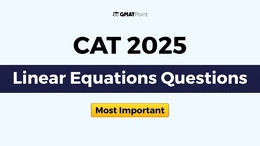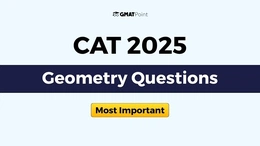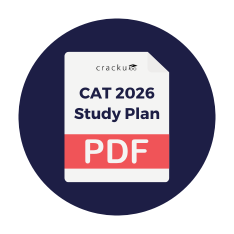Venn Diagram Questions For CAT 2025
Venn diagrams are an important topic for CAT 2025, often found in the Quantitative Aptitude section. These questions test how well you can understand and visualize the relationships between sets. In the exam, you'll typically deal with two or three sets, using concepts like union, intersection, and complement.
To help you prepare, we’ve provided a CAT Venn Diagrams Practice Questions PDF and an Important Formulas PDF. Practicing these questions will help you break down and understand the problems better. Focus on questions that ask you to find the number of elements in different parts of the diagram, especially those based on real-life examples.
Important Formulas for CAT Venn Diagram Questions
When preparing for Venn diagram questions in the CAT 2025 exam, it's important to know the key formulas that will help you solve these problems. Here are the most important formulas and concepts to remember:
Download CAT Venn Diagram Formula PDF
Inclusion-Exclusion Principle for Two Sets
For two sets A and B, the formula for the union of A and B, accounting for their intersection, is:
∣A∪B∣=∣A∣+∣B∣−∣A∩B∣|A \cup B| = |A| + |B| - |A \cap B|∣A∪B∣=∣A∣+∣B∣−∣A∩B∣
Where:
-
∣A∪B∣|A \cup B|∣A∪B∣ is the total number of elements in either set A or set B.
∣A∣|A|∣A∣ is the number of elements in set A.
-
∣B∣|B|∣B∣ is the number of elements in set B.
-
∣A∩B∣|A \cap B|∣A∩B∣ is the number of elements common to both sets A and B (intersection).
Inclusion-Exclusion Principle for Three Sets
For three sets A, B, and C, the formula for the union of these three sets is:
∣A∪B∪C∣=∣A∣+∣B∣+∣C∣−∣A∩B∣−∣B∩C∣−∣C∩A∣+∣A∩B∩C∣|A \cup B \cup C| = |A| + |B| + |C| - |A \cap B| - |B \cap C| - |C \cap A| + |A \cap B \cap C|∣A∪B∪C∣=∣A∣+∣B∣+∣C∣−∣A∩B∣−∣B∩C∣−∣C∩A∣+∣A∩B∩C∣
Where:
-
∣A∪B∪C∣|A \cup B \cup C|∣A∪B∪C∣ is the total number of elements in sets A, B, or C.
-
∣A∣|A|∣A∣, ∣B∣|B|∣B∣, and ∣C∣|C|∣C∣ are the individual number of elements in each set.
-
∣A∩B∣|A \cap B|∣A∩B∣, ∣B∩C∣|B \cap C|∣B∩C∣, and ∣C∩A∣|C \cap A|∣C∩A∣ are the numbers of elements common between each pair of sets.
-
∣A∩B∩C∣|A \cap B \cap C|∣A∩B∩C∣ is the number of elements common to all three sets.
Inclusion-Exclusion Principle for Four Sets
For four sets A, B, C, and D, the formula expands further:
∣A∪B∪C∪D∣=∣A∣+∣B∣+∣C∣+∣D∣−∣A∩B∣−∣A∩C∣−∣A∩D∣−∣B∩C∣−∣B∩D∣−∣C∩D∣+∣A∩B∩C∣+∣A∩B∩D∣+∣A∩C∩D∣+∣B∩C∩D∣−∣A∩B∩C∩D∣|A \cup B \cup C \cup D| = |A| + |B| + |C| + |D| - |A \cap B| - |A \cap C| - |A \cap D| - |B \cap C| - |B \cap D| - |C \cap D| + |A \cap B \cap C| + |A \cap B \cap D| + |A \cap C \cap D| + |B \cap C \cap D| - |A \cap B \cap C \cap D|∣A∪B∪C∪D∣=∣A∣+∣B∣+∣C∣+∣D∣−∣A∩B∣−∣A∩C∣−∣A∩D∣−∣B∩C∣−∣B∩D∣−∣C∩D∣+∣A∩B∩C∣+∣A∩B∩D∣+∣A∩C∩D∣+∣B∩C∩D∣−∣A∩B∩C∩D∣
Where:
-
∣A∪B∪C∪D∣|A \cup B \cup C \cup D|∣A∪B∪C∪D∣ is the total number of elements in sets A, B, C, or D.
-
The terms ∣A∣,∣B∣,∣C∣,∣D∣|A|, |B|, |C|, |D|∣A∣,∣B∣,∣C∣,∣D∣ are the number of elements in each set.
-
The pairwise intersections (∣A∩B∣,∣A∩C∣|A \cap B|, |A \cap C|∣A∩B∣,∣A∩C∣, etc.) represent the number of elements common between each pair of sets.
-
The triple intersections (∣A∩B∩C∣,∣A∩B∩D∣|A \cap B \cap C|, |A \cap B \cap D|∣A∩B∩C∣,∣A∩B∩D∣, etc.) represent the number of elements common between any three sets.
-
∣A∩B∩C∩D∣|A \cap B \cap C \cap D|∣A∩B∩C∩D∣ represents the number of elements common to all four sets.
Generalized Formula for Multiple Sets (n Sets)
For n sets A1,A2,A3,…,AnA_1, A_2, A_3, \dots, A_nA1,A2,A3,…,An, the generalized Inclusion-Exclusion formula is:
∣A1∪A2∪A3∪⋯∪An∣=∑i=1n∣Ai∣−∑1≤i<j≤n∣Ai∩Aj∣+∑1≤i<j<k≤n∣Ai∩Aj∩Ak∣−⋯+(−1)n+1∣A1∩A2∩⋯∩An∣|A_1 \cup A_2 \cup A_3 \cup \dots \cup A_n| = \sum_{i=1}^{n} |A_i| - \sum_{1 \leq i < j \leq n} |A_i \cap A_j| + \sum_{1 \leq i < j < k \leq n} |A_i \cap A_j \cap A_k| - \dots + (-1)^{n+1} |A_1 \cap A_2 \cap \dots \cap A_n|∣A1∪A2∪A3∪⋯∪An∣=i=1∑n∣Ai∣−1≤i<j≤n∑∣Ai∩Aj∣+1≤i<j<k≤n∑∣Ai∩Aj∩Ak∣−⋯+(−1)n+1∣A1∩A2∩⋯∩An∣
Where:
-
The first sum represents the individual sizes of each set.
-
The second sum subtracts the sizes of pairwise intersections.
-
The third sum adds the sizes of triple intersections.
-
This alternates until all intersections are considered.
This formula becomes increasingly complex as the number of sets increases, but it’s essential for problems involving multiple sets.
Complement of a Set
The complement of a set A (denoted as A') refers to the elements in the universal set that are not in A. If the universal set is U, the formula for the complement of A is:
∣A′∣=∣U∣−∣A∣|A'| = |U| - |A|∣A′∣=∣U∣−∣A∣
Where:
∣A′∣|A'|∣A′∣ is the number of elements not in set A.
∣U∣|U|∣U∣ is the total number of elements in the universal set.
∣A∣|A|∣A∣ is the number of elements in set A.
Common Mistakes to Avoid in Venn Diagram Questions
Incorrectly Interpreting Relationships Between Sets: Misunderstanding how sets relate to each other can lead to counting errors.
Ignoring the Complement of a Set: Not considering the complement can affect the final solution, especially in cases involving the universal set.
Misapplying the Inclusion-Exclusion Principle: Forgetting to subtract intersections or add triple intersections for three sets can result in wrong answers.
Rushing Through the Problem: Skipping the visualization step or not carefully considering all sections of the diagram can lead to counting mistakes.
Skipping Consistency Checks: Failing to ensure that your final counts match the problem's conditions can cause errors in the solution.
Help Distress (HD) is an NGO involved in providing assistance to people suffering from natural disasters. Currently, it has 37 volunteers. They are involved in three projects: Tsunami Relief (TR) in Tamil Nadu, Flood Relief (FR) in Maharashtra, and Earthquake Relief (ER) in Gujarat. Each volunteer working with Help Distress has to be involved in at least one relief work project.
- A Maximum number of volunteers are involved in the FR project. Among them, the number of volunteers involved in FR project alone is equal to the volunteers having additional involvement in the ER project.
- The number of volunteers involved in the ER project alone is double the number of volunteers involved in all the three projects.
- 17 volunteers are involved in the TR project.
-
The number of volunteers involved in the TR project alone is one less than the number ofvolunteers involved in ER project alone.
-
Ten volunteers involved in the TR project are also involved in at least one more project.
Question 1
Based on the information given above, the minimum number of volunteers involved in both FR and TR projects, but not in the ER project is:
correct answer:- 3
DIRECTIONS for the following two questions: Answer the questions on the basis of the information given below.
New Age Consultants have three consultants Gyani, Medha and Buddhi. The sum of the number of projects handled by Gyani and Buddhi individually is equal to the number of projects in which Medha is involved. All three consultants are involved together in 6 projects. Gyani works with Medha in 14 projects. Buddhi has 2 projects with Medha but without Gyani, and 3 projects with Gyani but without Medha. The total number of projects for New Age Consultants is one less than twice the number of projects in which more than one consultant is involved.
Question 2
What is the number of projects in which Gyani alone is involved?
correct answer:- 4
Question 3
In a locality, two-thirds of the people have cable TV, one-fifth have VCR, and one-tenth have both. What is the fraction of people having atleast one among cable -TV and VCR?
correct answer:- 4
Question 4
Shyam visited Ram during his brief vacation. In the mornings they both would go for yoga. In the evenings they would play tennis. To have more fun, they indulge only in one activity per day, i.e. either they went for yoga or played tennis each day. There were days when they were lazy and stayed home all day long. There were 24 mornings when they did nothing, 14 evenings when they stayed at home, and a total of 22 days when they did yoga or played tennis. For how many days Shyam stayed with Ram?
correct answer:- 3
Question 5
In a class of 100 students, 73 like coffee, 80 like tea and 52 like lemonade. It may be possible that some students do not like any of these three drinks. Then the difference between the maximum and minimum possible number of students who like all the three drinks is
correct answer:- 1





















